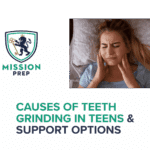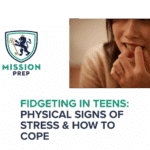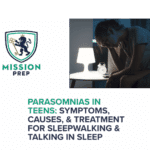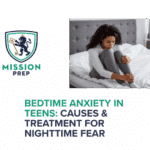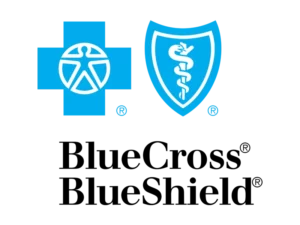Physical Symptoms of Social Anxiety & Panic in Teens: Causes & How to Cope

Imagine a teenager walking to the front of the classroom to deliver a presentation to their peers. They’re sweating and blushing, and their hands are trembling. Negative thoughts like, Everyone is going to think I’m dumb, and Stop blushing! stream through their mind. Why is this happening?
It’s normal to feel nervous when giving a presentation. But if thoughts and physical sensations such as these are the go-to when speaking in front of others, then a teen may have social anxiety.
Social anxiety disorder (SAD) is a highly prevalent mental health disorder that begins during adolescence. In fact, ten percent of adolescents develop SAD. In a nutshell, the condition is a fear of social situations that stems from a deep-seated worry about being judged negatively by others.
When left untreated, social anxiety disorder can have severe negative consequences that persist into adulthood – but it doesn’t have to. Thanks to extensive research in recent years, social anxiety disorder is very treatable.1 A mental health professional can guide you and your child through your options.
This page can also help you better understand the physical symptoms of social anxiety, as it explores:
- The causes of social anxiety
- The signs and physical symptoms of social anxiety
- If social anxiety goes away on its own
- Effective treatment options for social anxiety
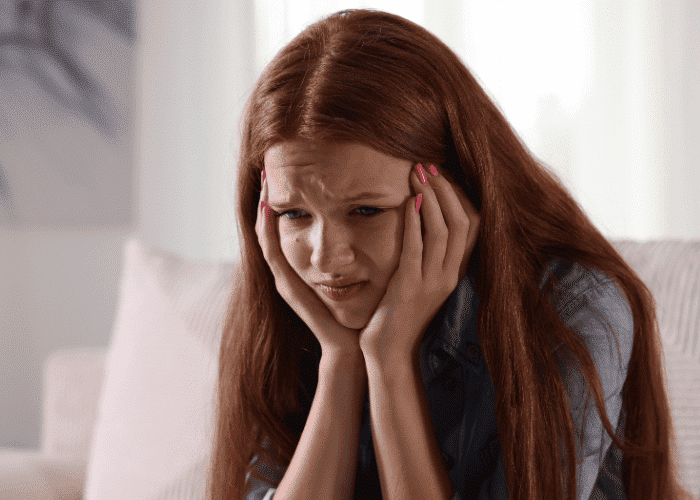
What Is Social Anxiety?
Social anxiety disorder is a chronic fear of social interactions that stems from worry about being judged negatively by others. Affecting approximately 10 out of every 100 adolescents in the United States, social anxiety is the third most common mental health disorder.2 Further, social anxiety often develops during adolescence and typically does not go away on its own.2
Much more severe than “shyness,” this condition can drastically impact numerous aspects of a teen’s life. This is because people with social anxiety disorder often find it challenging to conduct many everyday activities. For instance, talking on the phone, speaking with a stranger, walking into a room where people are already seated, and joining teams can feel overwhelming. To avoid intense fear and discomfort from such activities, teens with social anxiety disorder usually try to avoid them. This can increase anxiety and lead to missed opportunities and social isolation.
When social interactions cannot be avoided, people with SAD often experience intense dread before, physical and emotional discomfort during, and humiliation and shame after the social event. In other words, a brief social situation can cause days, weeks, or even months of intense distress for a person with social anxiety disorder.
What Causes Social Anxiety in Teens?
Teens with social anxiety typically fear that they will say or do something to humiliate or embarrass themselves. This fear is so uncomfortable that they often avoid everyday interactions, such as talking on the phone, going to school football games, or joining teams. But what causes this deep-rooted fear?
Anxiety in teens doesn’t come from one single factor. It’s actually often the result of genetic, environmental, and biological issues. However, two common underlying beliefs are thought to contribute to the development of social anxiety.
First, as children grow into adolescents, it is developmentally appropriate to place more emphasis on peer acceptance than they did as children. However, teens with social anxiety regard peer approval with excessive importance. So they subconsciously believe that it is imperative to maintain a positive image at all times, with all people – and no room for mistakes.
Secondly, socially anxious teens tend to rate their social performance negatively; they believe they make a bad impression or “fail”, even when an interaction is positive or neutral.
These interpretations of social failure are added into their memory bank as evidence that they are “weird” or “awkward,” strengthening their belief in their own social incompetence.
What Are the Behavioral Signs of Social Anxiety
If anxiety around others is commonplace for you or your teen, it’s natural to wonder if social anxiety is present. But how can you tell for sure? For starters, there are some behavioral signs of social anxiety.
Teens with social anxiety place high importance on peer approval and are self-critical about their own social abilities. This combination can make everyday activities feel like high-pressure events. So a teen with social anxiety who plans to attend an upcoming social event, like a school football game, is likely to spend days worrying about how it will go.
As they consider the possible outcomes, they may review past events in which they believe they embarrassed themselves. With these memories in mind, they might make negative predictions about the approaching activity. This can intensify feelings of dread and worry, often resulting in avoidance; ultimately, they may decide not to attend the football game.
Other behavioral signs of social anxiety disorder include the following.3
Behavioral Signs of Social Anxiety in Teens
Teens with social anxiety may avoid…
- Phone calls, preferring to text instead
- Speaking to strangers
- Hanging out with peers outside of school
- Eating or drinking in public
- Entering a room where people are already seated
- Public speaking or taking tests
- Team or group activities
In addition to these signs, a teen might spend hours predicting or rehearsing upcoming social events. They might also recall past social events with a sense of shame.
While avoidance is one of the most common coping strategies for anxiety teens try, it is actually harmful and only worsens the condition. While avoidance may bring an immediate sense of relief to the teen, this strategy actually maintains or prolongs social anxiety disorder in the long run.
For this reason, a significant component of treatment for SAD is exposure to social situations.4 When they face a dreaded social event, they learn that the predicted worst-case scenarios usually don’t actually happen. Thus, the social anxiety weakens. Furthermore, as the person faces their anxiety, they develop healthier ways to cope with anxious feelings.4
What Are the Emotional Signs of Social Anxiety?
Teens with social anxiety often experience many mental and emotional symptoms that can impact their well-being.
First, they tend to be very critical of their social abilities or social performance. So, before an upcoming social activity, they may spend hours imagining the event, recalling past “failures”, and predicting negative outcomes.
During a social interaction, they may unintentionally focus on their distressing inner thoughts and experiences. For example, they may become so distracted by thoughts like Why did I just say that? or I’m so awkward that connecting positively with others becomes difficult.
Finally, after socializing, teens with the disorder tend to ruminate on their experience, focusing on the negative aspects or replaying their perceived missteps.
In addition to these emotional signs, teens with social anxiety may also:
- Fear being viewed as “weird,” “incompetent,” “stupid,” or “boring”
- Believe that they actually are different, embarrassing, or boring
- Experience intense fear of blushing, stuttering, or sweating in front of others
- Fear they will do or say something humiliating
If your teen experiences negative thoughts and feelings like these before, during, and long after a social interaction, it could be due to social anxiety.
What Are the Physical Symptoms of Social Anxiety?
In addition to behavioral and emotional signs, there are several common physical symptoms of social anxiety disorder.
Think back to the beginning of this page, where we described a teen walking to the front of a classroom to give a speech. They were sweating excessively, their hands were shaking, and they were blushing.
Physical reactions like these often arise from the deep fear of humiliation that occurs in social anxiety, as it can lead someone to view ordinary daily activities as high-pressure situations. The intense fear of being scrutinized by others can feel like a genuine “threat.”
As a result of perceived threat, the physical stress response in adolescents can become activated.5 Therefore, social anxiety causes physical symptoms such as:5,6
- Fast talking
- Trembling or shaking
- Blushing or feeling flushed
- Heart pounding
- Dizziness or feeling faint
- Stomachache, nausea, or diarrhea
- Frequent urges to urinate
When casual social interactions cause physical symptoms like these, social anxiety should be considered. Identifying social anxiety disorder is important because treatment can improve a teen’s quality of life and reduce distress.
Can Social Anxiety Cause Panic Attacks?
Social anxiety in teens can be mild, moderate, or severe. However, severe social anxiety can lead to panic signs in teens.
Panic attack warning signs teens experience include the physical symptoms listed above, as well as:7
- Fear that something terrible is happening
- Shortness of breath
- A sensation of choking or being smothered
- Feeling out of touch with reality
- Feeling like you’re dying, losing control, or losing your mind
People with this degree of social anxiety can experience severe impairment, making daily functioning extremely difficult.
Risks of Untreated Social Anxiety
Is it okay to adopt a “wait-and-see” policy when it comes to social anxiety? Is a teen likely to outgrow it? In general, waiting it out is not recommended. Like many mental health conditions, untreated social anxiety can cause severe impairment in all areas of a teenager’s life.
Teens with social anxiety are at risk of having fewer friends, becoming victims of bullying, and struggling with daily activities like shopping or making a phone call.2 Further, social anxiety disorder tends to impact academic performance negatively.
Aside from these immediate impacts, untreated social anxiety can persist into adulthood. Adults with social anxiety tend to have more absences, are less productive, and earn 10% less pay in the workforce.6 They’re also less likely to marry and have children, and are more likely to divorce.6 With such serious consequences of untreated social anxiety, mental health experts recommend early intervention.
Teen Anxiety Support Programs: Treatments That Work
The good news is that there are effective, science-backed treatments for social anxiety. Plus, evidence indicates that early intervention is associated with the most favorable outcomes.2
Recent studies consistently confirm that psychotherapy is an effective treatment option for anxiety.9 There are many formats of psychotherapy, such as cognitive behavioral therapy (CBT), acceptance and commitment therapy (ACT), and mindfulness-based cognitive therapy.
While studies show that all types of psychotherapy can be effective for social anxiety disorder, mental health specialists often refer to CBT as the gold-standard treatment for social anxiety.1,9 This is because studies show that CBT, delivered individually or in a group setting, can effectively treat this condition in teens.1
Through cognitive behavioral therapy for anxiety, youth learn how thoughts and behaviors affect the outcome of social experiences. They then learn practical steps to challenge thoughts and replace behaviors with more effective, externally focused actions.2 Furthermore, studies show that in-person and remotely-delivered CBT are both highly effective treatments for SAD.8

Mission Prep: Professional Support for Teens With Social Anxiety
At Mission Prep, we offer a wide variety of effective teen anxiety support programs. Providing outpatient, intensive outpatient, and inpatient residential mental health treatment, we ensure that our approach is tailored to your teen’s needs.
Licensed therapists at Mission Prep provide one-on-one therapy, where teens find a safe, nonjudgmental space to work through mental health challenges. Some teens with social anxiety disorder prefer this format because they enjoy working individually with a compassionate therapist in full confidentiality.
However, we also offer group therapy for anxiety. Teens with social anxiety disorder may choose group therapy for an opportunity to connect with peers experiencing similar mental health challenges. For instance, they may find it comforting to engage with other adolescents with similar issues and support each other throughout the treatment process.
Whichever approach your family chooses to take, we are here to support you. Social anxiety is treatable and does not have to rule your life. Contact us today so that together, we can begin the journey toward optimal mental health.
References
1. Wolitzky-Taylor, K., & LeBeau, R. (2023). Recent advances in the understanding and psychological treatment of social anxiety disorder. Faculty Reviews, 12, 8. https://doi.org/10.12703/r/12-8
2. Leigh, E., & Clark, D. M. (2018). Understanding social anxiety disorder in adolescents and improving treatment Outcomes: Applying the Cognitive Model of Clark and Wells (1995). Clinical Child and Family Psychology Review, 21(3), 388–414. https://doi.org/10.1007/s10567-018-0258-5
3. Ernst, J., Ollmann, T. M., König, E., Pieper, L., Voss, C., Hoyer, J., Rückert, F., Knappe, S., & Beesdo-Baum, K. (2022). Social anxiety in adolescents and young adults from the general population: an epidemiological characterization of fear and avoidance in different social situations. Current Psychology, 42(32), 28130–28145. https://doi.org/10.1007/s12144-022-03755-y
4. Chowdhury, N., & Khandoker, A. H. (2023). The gold-standard treatment for social anxiety disorder: A roadmap for the future. Frontiers in Psychology, 13, 1070975. https://doi.org/10.3389/fpsyg.2022.1070975
5. Ghasemi, F., Beversdorf, D. Q., & Herman, K. C. (2024). Stress and stress responses: A narrative literature review from physiological mechanisms to intervention approaches. Journal of Pacific Rim Psychology, 18. https://doi.org/10.1177/18344909241289222
6. Alomari, N. A., Bedaiwi, S. K., Ghasib, A. M., Kabbarah, A. J., Alnefaie, S. A., Hariri, N., Altammar, M. A., Fadhel, A. M., & Altowairqi, F. M. (2022). Social anxiety Disorder: associated conditions and therapeutic approaches. Cureus, 14(12), e32687. https://doi.org/10.7759/cureus.32687
7. Aacap. (n.d.). Panic disorder in children and adolescents. https://www.aacap.org/AACAP/Families_and_Youth/Facts_for_Families/FFF-Guide/Panic-Disorder-In-Children-And-Adolescents-050.aspx


